When measuring my speaker’s in room response I usually measure left + right together, and then left and right separately. The combined response is useful for assessing lower frequencies (as mentioned somewhere in the REW info), particularly decay, but isn’t good for higher frequencies when looking at individual speaker measurements is more accurate. Measurements of individual speakers are also useful in the lower frequencies but I find it useful to also see how the two speakers are interacting with each other.I don't ever measure both speakers at the same time or we could test your hypothesis. From which source did you get the idea that the two speakers should be measured at the same time?
You are using an out of date browser. It may not display this or other websites correctly.
You should upgrade or use an alternative browser.
You should upgrade or use an alternative browser.
Room correction/DSP
- Thread starter flak monkey
-
Start date
- Views 4,143
@tuga @newlash09 I see benefits to both approaches. But understanding the fundamentals/theory also can allow you to make better informed decisions. I enjoy reading the theory as it gives me a better fundamental understanding and let's me see where I'm going wrong. However, sound is very subjective, so while I like using measurements as a basis, I still like to listen and adjust things to preference.
Turn out that Roon maybe does have individual channel EQ, I need to play with that today. Will share my "half baked" results later...
Turn out that Roon maybe does have individual channel EQ, I need to play with that today. Will share my "half baked" results later...
Last edited by a moderator:
This is absolutely the right thing to doHowever, sound is very subjective, so while I like using measurements as a basis, I still like to listen and adjust things to preference.
How do you do that in roon?@tuga @newlash09 I see benefits to both approaches. But understanding the fundamentals/theory also can allow you to make better informed decisions. I enjoy reading the theory as it gives me a better fundamental understanding and let's me see where I'm going wrong. However, sound is very subjective, so while I like using measurements as a basis, I still like to listen and adjust things to preference.
Turn out that Roon maybe does have individual channel EQ, I need to play with that today. Will share my "half baked" results later...
I would fully agree sir..each on their own journey to learn along the way I guess.This is absolutely the right thing to do.
The lady was trying to mend posts. So please explain yourselves. ThanksHow do you do that in roon?
If you use the same time reference for both, you can measure each speaker response separately and then calculate the sum in REW. I'm somewhat wondering what you are describing as a hypothesis though so let's break this down...I don't ever measure both speakers at the same time or we could test your hypothesis.
Do you understand and agree with my key point? This is, if you were able to EQ the amplitude response of each speaker at the listening position to be identically smooth (flat or whatever shape you want), the sum would not be flat if there were differences in the phase responses of the two. This is mathematical and therefore acoustical fact, not a some sort of hypothesis.
To take an extreme example just to maybe help explain the point - if you have an equal amplitude from each speaker but they end up being perfectly out of phase at the listening position, then they will sum to zero. Consider panning the signal level from all on the left, through equal on each channel, to all on the right. What would be heard at the listening position would be that the sound level will start at one level and gradually drop as the signal moves to the center, and then rise again as it's moved to the right to get back up to the starting level. For the low-bass frequencies I'm talking about this is purely a level change, not something that affects the direction the sound appears to be coming from.
You very likely don't normally look at the phase responses but for info. when the measured amplitude responses for the two speakers are different it is basically guaranteed that the phase responses will differ too. It's a consideration I've likely looked at more as it affects my choice of crossover frequency between main speakers and subwoofer. I first realised the issue when considering EQ for my own speakers but then switched to using a subwoofer which removed the complication
For clarity let me also stress that I have not dogmatically said something like 'everyone must EQ low-bass based on the sum of left and right speaker signals'. What I've done is explain that there is reason to consider both the individual and summed signals. The nature of low-bass signals in I suspect most recordings does though make me lean towards prioritising using the combined response. What this certainly means is that I won't pronounce as 'wrong' someone who does this and likes the result.
I'm afraid what I've shared above has come from my own brain, based on application of my own knowledge and experience rather than something that I can point you to some particular source for.From which source did you get the idea that the two speakers should be measured at the same time?
That makes sense (regarding decay). Interaction information I don’t find particularly useful but it could be if you are using a sub (or a pair of subs).When measuring my speaker’s in room response I usually measure left + right together, and then left and right separately. The combined response is useful for assessing lower frequencies (as mentioned somewhere in the REW info), particularly decay, but isn’t good for higher frequencies when looking at individual speaker measurements is more accurate. Measurements of individual speakers are also useful in the lower frequencies but I find it useful to also see how the two speakers are interacting with each other.
When listening we hear the two speakers playing together and so it is useful to measure them playing together. Summing the left and right measurements doesn’t necessarily give the same result, although it might be similar in a very symmetrical room layout.That makes sense (regarding decay). Interaction information I don’t find particularly useful but it could be if you are using a sub (or a pair of subs).
For higher frequencies, separate speaker measurements are best, but for lower frequencies I find separate measurements useful to see what is happening but a measurement with both speakers playing useful to see what we are actually hearing.
I don't get listening to one speaker which I have read in some reviews, are they inputing in mono or just playing one channel. With 1 speaker you won't get the same soundstage, totally different and some music won't make sense, I don't see the point.When listening we hear the two speakers playing together and so it is useful to measure them playing together. Summing the left and right measurements doesn’t necessarily give the same result, although it might be similar in a very symmetrical room layout.
For higher frequencies, separate speaker measurements are best, but for lower frequencies I find separate measurements useful to see what is happening but a measurement with both speakers playing useful to see what we are actually hearing.
The primary purpose of this part of the forum is to share subjective experiences of equipment and accessories we've tried in our own HiFi or what we have heard in shop demos, bakeoffs and shows. In that context it makes perfect sense to discuss relevant HiFi reviews too. What we haven't signed up for is 'HiFi as a science experiment' and there are other forums which might be more targeted at that.So you feel that your comments are less agreesive and ad hominem by adding a dumb
Good for you.
Yes I use graphs to prove and also to illustrate a point. I also find it strange that people would rather read reviews instead of learning about audio. Strange world...
The result will be the same no matter what the layout, provided the same and accurate timing reference is used for both measurements, and the sum is the (mathematically) complex sum rather than simply adding the amplitude responses.When listening we hear the two speakers playing together and so it is useful to measure them playing together. Summing the left and right measurements doesn’t necessarily give the same result, although it might be similar in a very symmetrical room layout.
In practice for most it's probably simplest to just measure the two playing together though.
I think that’s the distinction between measuring to find out what is going on and listening to the music as the final result; the former done to improve the latter - hopefully.I don't get listening to one speaker which I have read in some reviews, are they inputing in mono or just playing one channel. With 1 speaker you won't get the same soundstage, totally different and some music won't make sense, I don't see the point.
As you will gather from this thread there are different approaches to doing this measurement malarkey. When it comes to using REW I err towards the views of the designer of the software, but in the last analysis REW is a tool and as with many tools there are different, perfectly valid, ways of using it.
Some results from messing around at lunchtime. I won't pretend these are perfect, but I thought I would play with EQ of individual speakers or both at the same time.
Left speaker, pre and post EQ (blue pre, green post)
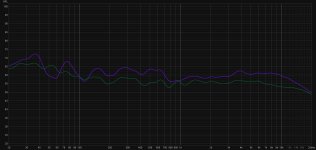
Right speaker pre and post EQ (purple pre, red post)
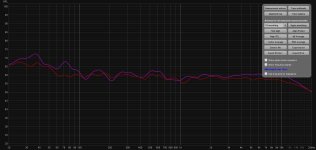
Individual measurements of left (green), right (red) and combined (blue) post EQ
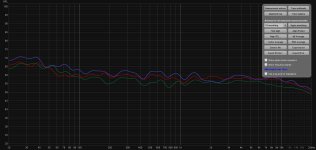
As far as the difference between EQing both together or separately, here's a direct comparison - Red is the result of EQing both speakers together, no individual measurements made. The blue is the result of EQing both speakers independently and then summing the result.
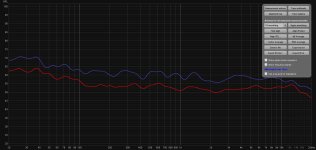
Left speaker, pre and post EQ (blue pre, green post)

Right speaker pre and post EQ (purple pre, red post)

Individual measurements of left (green), right (red) and combined (blue) post EQ

As far as the difference between EQing both together or separately, here's a direct comparison - Red is the result of EQing both speakers together, no individual measurements made. The blue is the result of EQing both speakers independently and then summing the result.

Last edited by a moderator:
I don't agree.When listening we hear the two speakers playing together and so it is useful to measure them playing together. Summing the left and right measurements doesn’t necessarily give the same result, although it might be similar in a very symmetrical room layout.
For higher frequencies, separate speaker measurements are best, but for lower frequencies I find separate measurements useful to see what is happening but a measurement with both speakers playing useful to see what we are actually hearing.
Unless the speakers are positioned in such a way that their response below 300Hz is identical, applying the same EQ correction to two speakers with a different response will neither make the individual nor the combined sound flatter at the listening spot. See below at 64Hz, 87Hz, 100Hz...

It is never wrong if someone likes the result. It just does not make for a more accurate transduction of the recording/sugnal at the listening spot.If you use the same time reference for both, you can measure each speaker response separately and then calculate the sum in REW. I'm somewhat wondering what you are describing as a hypothesis though so let's break this down...
Do you understand and agree with my key point? This is, if you were able to EQ the amplitude response of each speaker at the listening position to be identically smooth (flat or whatever shape you want), the sum would not be flat if there were differences in the phase responses of the two. This is mathematical and therefore acoustical fact, not a some sort of hypothesis.
To take an extreme example just to maybe help explain the point - if you have an equal amplitude from each speaker but they end up being perfectly out of phase at the listening position, then they will sum to zero. Consider panning the signal level from all on the left, through equal on each channel, to all on the right. What would be heard at the listening position would be that the sound level will start at one level and gradually drop as the signal moves to the center, and then rise again as it's moved to the right to get back up to the starting level. For the low-bass frequencies I'm talking about this is purely a level change, not something that affects the direction the sound appears to be coming from.
You very likely don't normally look at the phase responses but for info. when the measured amplitude responses for the two speakers are different it is basically guaranteed that the phase responses will differ too. It's a consideration I've likely looked at more as it affects my choice of crossover frequency between main speakers and subwoofer. I first realised the issue when considering EQ for my own speakers but then switched to using a subwoofer which removed the complication.
For clarity let me also stress that I have not dogmatically said something like 'everyone must EQ low-bass based on the sum of left and right speaker signals'. What I've done is explain that there is reason to consider both the individual and summed signals. The nature of low-bass signals in I suspect most recordings does though make me lean towards prioritising using the combined response. What this certainly means is that I won't pronounce as 'wrong' someone who does this and likes the result.
I'm afraid what I've shared above has come from my own brain, based on application of my own knowledge and experience rather than something that I can point you to some particular source for.
When room boundaries affect frequency response do they not also affect phase?


Would you mind exporting the plots with the vertical (Y) scale reduced to 50dB and apply a bit less smoothing (perhaps 1/24 octave)? As it stands the resolution is very limited.Some results from messing around at lunchtime. I won't pretend these are perfect, but I thought I would play with EQ of individual speakers or both at the same time.
Left speaker, pre and post EQ (blue pre, green post)
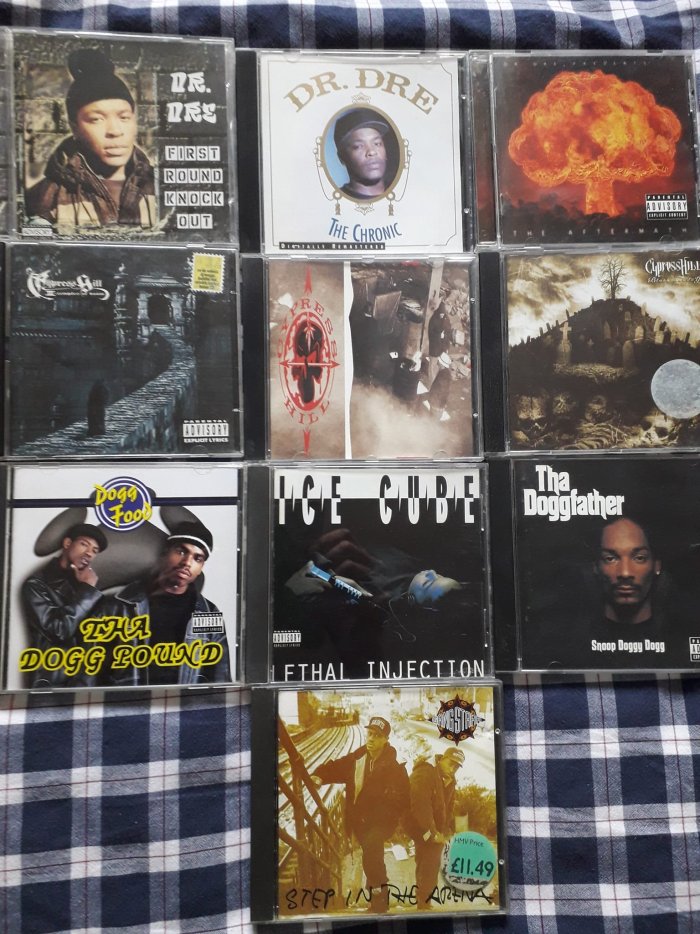
Right speaker pre and post EQ (purple pre, red post)
![IMG_0824[1].JPG IMG_0824[1].JPG](https://www.hifiwigwam.com/data/attachments/107/107632-469f9d990dadd6b9c76b47d5c02e37f7.jpg)
Individual measurements of left (green), right (red) and combined (blue) post EQ

As far as the difference between EQing both together or separately, here's a direct comparison - Red is the result of EQing both speakers together, no individual measurements made. The blue is the result of EQing both speakers independently and then summing the result.
If two speakers are pressurizing the room with bass, the bass of the two will interfere with each other whether or not they both have the same EQ. So you cannot set the EQ anymore correctly by simply measuring one speaker or one sub at a time because it wouldn’t account for that interference.I don't agree.
Unless the speakers are positioned in such a way that their response below 300Hz is identical, applying the same EQ correction to two speakers with a different response will neither make the individual nor the combined sound flatter at the listening spot. See below at 64Hz, 87Hz, 100Hz...

Sure - same again but with more wiggles to show just how crap my room really is!Would you mind exporting the plots with the vertical (Y) scale reduced to 50dB and apply a bit less smoothing (perhaps 1/24 octave)? As it stands the resolution is very limited.
Left before (blue) and after (green)
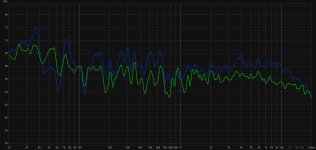
Right before (purple) and after (red)
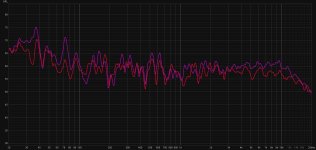
Individually EQ - left (red), right (green), both (blue)
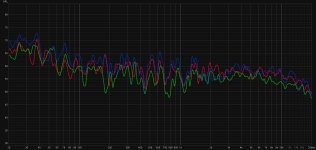
And comparing the overall response of EQ of both together (red) or individually (blue)
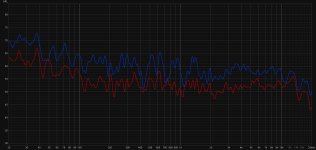
Similar threads
- Replies
- 228
- Replies
- 61
- Replies
- 70
Forum statistics
Latest Articles
-
Review Chord Electronics 2go/2yu 2 - Mea CulpaChord Electronics 2go/2yu - (£1,445) Introduction In May 2023 I...
- Mr Underhill
- Updated:
- 6 min read
-
Review Triangle Comete 40th AnniversaryTriangle Comete 40th Anniversary - £1,499 (Premium Finish) Martin Virgo...
- Mr Underhill
- Updated:
- 6 min read
-
Review Denafrips Ares 12th-1 ReviewDenafrips Ares 12th-1 DAC – S$1,549 Denafrips Iris 12th DDC - S$899...
- Mr Underhill
- Updated:
- 10 min read



